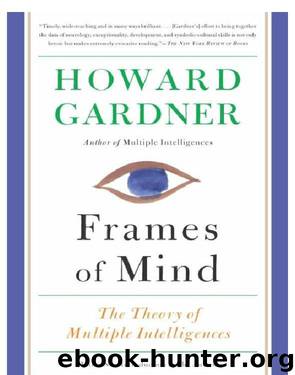Frames of Mind by Howard Gardner

Author:Howard Gardner [Gardner, Howard]
Language: eng
Format: epub, mobi
Publisher: Basic Books
Published: 2011-02-03T21:00:00+00:00
The Brain’s Role in Bodily Movement
While studies of perception and language have dominated published treatments in neuropsychology, the saga of the brain’s role in physical activity proves to be as intriguing as reports about the aphasias or as accounts of the detection of edges, lines, colors, and objects. And, indeed, even as bodily intelligence may have been taken for granted, or minimized in importance by many researchers, motor activity has been considered as a less “high” cortical function than functions subserving “pure” thought. Yet, as Roger Sperry, the doyen of American neuropsychologists, has shrewdly pointed out, one should look upon mental activity as a means to the end of executing actions. Rather than motor activity as a subsidiary form designed to satisfy the demands of the higher centers, one should instead conceptualize cerebration as a means of bringing “into motor behavior additional refinement, increased direction toward distant, future goals and greater overall adaptiveness and survival value.”
It is hardly an exaggeration to say that most segments of the body (and the nervous system) participate in one or another way in the execution of motor actions. The various agonist and antagonist muscles, joints, and tendons are involved in the most direct ways. Our kinesthetic sense, which monitors the activity of these regions, allows us to judge the timing, force, and extent of our movements and to make necessary adjustments in the wake of this information. Within the nervous system, large portions of the cerebral cortex, as well as the thalamus, the basal ganglia, and the cerebellum, all feed information to the spinal cord, the way station en route to the execution of action. Paradoxically, whereas the cortex serves as the “highest” center in most forms of human activity, it is the relatively lowly basal ganglia and the cerebellum that contain the most abstract and complex forms of “representation of movements”; the motor cortex is more directly tied to the spinal cord and the actual execution of specific muscular movements.
For my purposes it is not necessary to review the mass of information that has been secured about the physical operation of the bodily-kinesthetic systems in human beings, but it is germane to call attention to some general principles that have emerged. To begin with, the operation of the movement system is tremendously complex, calling upon the coordination of a dizzying variety of neural and muscular components in a highly differentiated and integrated fashion. For example, in the movement of the hand to retrieve an element or to throw or catch an object, there is extremely intricate interaction between the eye and the hand, with the feedback from each particular movement allowing more precisely governed subsequent motion. Feedback mechanisms are highly articulated, so that motor movements are subjected to continuous refinement and regulation on the basis of a comparison of the intended goal state and the actual position of the limbs or body parts at a particular moment in time.
In fact, voluntary movements require perpetual comparison of intended actions with the effects actually achieved:
Download
This site does not store any files on its server. We only index and link to content provided by other sites. Please contact the content providers to delete copyright contents if any and email us, we'll remove relevant links or contents immediately.
The Art of Thinking Clearly by Rolf Dobelli(10234)
The 5 Love Languages: The Secret to Love That Lasts by Gary Chapman(9609)
Mindhunter: Inside the FBI's Elite Serial Crime Unit by John E. Douglas & Mark Olshaker(9214)
Becoming Supernatural by Dr. Joe Dispenza(8127)
Nudge - Improving Decisions about Health, Wealth, and Happiness by Thaler Sunstein(7622)
The Road Less Traveled by M. Scott Peck(7525)
Enlightenment Now: The Case for Reason, Science, Humanism, and Progress by Steven Pinker(7244)
Mastermind: How to Think Like Sherlock Holmes by Maria Konnikova(7234)
Win Bigly by Scott Adams(7097)
The Way of Zen by Alan W. Watts(6513)
Factfulness: Ten Reasons We're Wrong About the World – and Why Things Are Better Than You Think by Hans Rosling(4696)
The State of Affairs by Esther Perel(4645)
Gerald's Game by Stephen King(4584)
Man's Search for Meaning by Viktor Frankl(4438)
The Confidence Code by Katty Kay(4193)
Thinking in Bets by Annie Duke(4154)
The Healing Self by Deepak Chopra(3478)
Hidden Persuasion: 33 psychological influence techniques in advertising by Marc Andrews & Matthijs van Leeuwen & Rick van Baaren(3476)
The Worm at the Core by Sheldon Solomon(3438)
